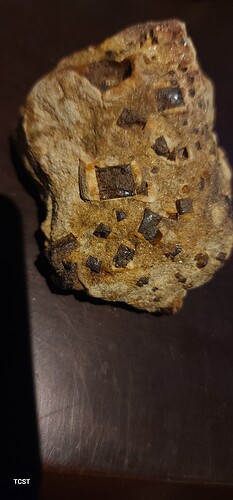Any advice on how to clean this one faster than with a toothbrush?
Do you have access to an ultrasonic tank? Especially one that has a drop down basket.
I do not. But I can order one any recommendations?
Many of the jewelry supply houses sell ultrasonic cleaners. I would recommend mild solution a short cycle to see how much of the base rock is rock and how much of it is rock.
Place the item the basket, fill the tank with mild solution and lower the basket. Set the timer for 30 minutes and see the results. I
Thanks i more was looking for a brand you recommend but all information is helpful.
I bought a Vevor Transonic a number of years ago, but I cannot recall how much I paid. I was doing a lot of serious cabbing then and used the machine to clean the rough.
It has a drop in basket, timer, and heats the water. It did a great job on most of the rough. The big caution is not to use on with gems that may fracture easily due to cleavage planes (like Topaz).
I also used an electric tooth brush and mild dish soap on stones that were not as encrusted.
I tried to take a picture of the transonic, but we are in the middle a storm and is on my screened porch.
Hopefully this info helps.
Larry
It helps a lot thank you for going to so much trouble for me. Although these are garnet so i think thats a bad idea for these stones
You could use a lapidary saw to cut around the gem deposits. If you don’t already ahve one, this model looks like it would be good for entry level work: Lapidary 4" Trim Saw by Ameritool
There are cheaper options, but this one looks the most beginner friendly.
Thanks I literal had an epiphany yesterday and I am so not ready to cut anything until I talk to an expert. THIS stone made it all click. Im going to make an appointment at the natural history musium in DC asap.
I have text books to change…
Understandable. Though, now I am curious. What is this epiphany?
You can use an Oxalic Acid bath for 8 hours then but in a wash of warm water and dish soap for another hour. Also you can purchase on places like harbor frieght a small sand blast gun that you can gently blow away some matrix. These things aren’t expensive but each should be used with caution. The acid should be done in warm water, with gloves and a respirator and eye protection in a very well ventilated place. using these tools will give you professional results. You can also try white vinegar for several hours then take it out of the vinegar bath and then soak in a baking soda and water mix which will bubble like hell and lift loose debris off without compromising the garnets. Last but not least you can get a fine wire or nylon drill brush attachment and on slow speed use that attached on a drill to remove some matrix. I’ve used all these over the past 50 years and each has its pro’s and cons. -
Mike at Acquire Collectibles Gemological Laboratory Services
Hello,
according to the Crystallization it doesn’t look like Garnet . Maybe I am wrong .
It turns out it is Staurolite with garnets i live on previosly undiscovered high grade sedimentary
To metamorphic rock all the way to gneiss, marble, schist…
Lucky you. Get your pics, shovels, screens and books, and have fun.
Im a severely disabled woman with nothing but time and the adhd hyperfocus and high masking diagnosed at 41 autistic with a special interest of …science.
When i was diagnosed with narcolepsy at 40. My "spawn point " slipped up and well the jig was up i saw how the trick was done… i cut off my entire family on my 41st birthday. My life fell apart i started healing i dedicated my life to helping others and took a vow of poverty… cause why not on ssdi im already there…
Then I find this …in my yard
Im still 42
What is that stone? It’s always cool to see your finds, you seem to have a hawks-eyesight for nice stones. Keep posting them, especially in unworked form. I’ve been making mental notes of all this as stuff to look for.
My background is chemistry so I look at whether I want to preserve the specimen but enhance the main mineral or to free up the mineral that I want from the matrix. There are several old museum publications etc available on cleaning specimens and these tend to use non-aggressive acids or alkalis with or without ultrasonics. The coating and matrix destroyers generally are strong acids and bases that need to be handled properly and involve prior identification of whether they dissolve or adversely change the mineral you want to clean up. Unfortunately, there is limited information available on the Net of what minerals are dissolved by various acids and bases. It is often best to look at information on the mineral treatment and processing of a particular mineral to assess what treatment it can withstand during purification/beneficiation.



